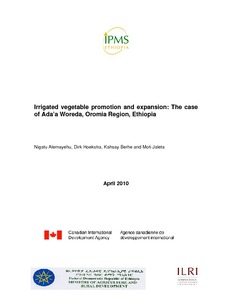Resource information
In 2005, irrigated vegetables were identified as one of the marketable commodities by the stakeholders participating in the IPMS project. At the time, most vegetables were grown in gravity fed traditional and modern irrigation schemes getting water from two micro dams constructed by the Cubans during the previous government. Following the identification of irrigated vegetables as a potential for the district, a participatory market oriented value chain development approach was introduced to increase vegetables production and productivity with the aim of improving the livelihood of rural population.
The development and research partners started improving production in gravity fed irrigation schemes by creating interest in a more business like commercial production system. Study tours and training activities were organized on more advanced irrigation practices (furrow instead of flood irrigation) as well as the introduction of new onion and tomato varieties. The latter enabled farmers to expand their irrigated vegetable production areas since these varieties are grown from seeds which are readily available and relatively cheap, as compared to, for example, the traditional onion (shallot) varieties which are grown from bulbs.
Using participatory planning methods, project partners then examined the potential for irrigation from rivers and groundwater with the help of small pumps. Several groups were identified and credit was provided by the Erer Union, which received the funds from the IPMS credit innovation fund. Pumps were owned by one of the group members, who used it for him/herself and provided water services on a commercial basis to others. Again, study tours and training activities were organized to create interest and skills. Close ties developed between these farmers and the Meki and Ziway farmers visited during the study tour. In the end this contributed significantly to skills development, especially since Meki and Ziway farmers also started renting in land along the Mojo river for dry season irrigated vegetables production. Government furthermore supported the development of pump irrigated agriculture and supplied more pumps (on credit) through the Oromia Water Enterprise to farmers, especially youth groups.
The results of all these interventions are visible in a very significant expansion of irrigated areas, especially during the dry season. Since 2005, pump irrigated areas increased from 60 to 1000 ha in 2009, (mainly along the Mojo river). The area of irrigated onion and tomatoes from gravity fed irrigation and pump irrigation increased from about 400 ha in 2005 to 4800 ha in 2009.In terms of income from irrigated dry season vegetables, a comparison between adopters and non-adopters of the market oriented value chain development approach shows significant difference, i.e. Birr 17,293 and Birr 8,886 per household, respectively. Special attention was given to a group of women farmers, who received special training and are now used as “models” for other women farmers. Further improvements are possible particularly in improving productivity, since yields are much lower than can be obtained under good management. Care should further more be taken to avoid over utilization of water in the Woreda, especially since ground water is also extracted by large scale commercial horticultural farms.


